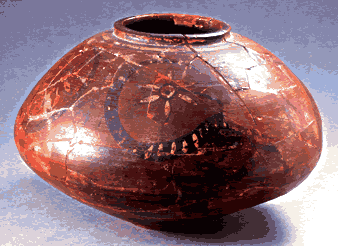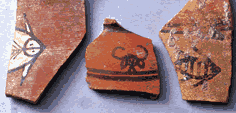
 |
|
These globe-shaped, short-necked pots from Kot Diji are characteristic of Early Harappan material culture. On one well-known example, a figure with horns and flowers (or stars?) probably representing a deity is painted below the neck of the pot on a red field. |
|
|
This type of polychrome pottery from the lowest (earliest) levels at Harappa was made around 3300 B.C., before the advent of the Indus Civilization. The pottery was made completely by hand (rather than on a wheel). The designs are painted in shades of white, red and black. The motif of intersecting circles (shown in an early somewhat disjointed form) on the left pot was refined and continued as a popular motif in the pottery of the Indus Civilization. The waterfowl painted on the right pot were probably part of a familiar scene at Harappa, which was located near the Ravi River. |
|
|
Painted pottery with a variety of motifs appeared in many areas of South Asia prior to the rise of the Indus Civilization. Images of horned deities were sometimes painted on short-necked pots such as this one from the early levels at the site of Rahman Dheri, where fish motifs on pottery were also common. |
|
[home] [prev] [next] |
|
| [Environment] [The dawn of civilization] [Indus Civilization] [The successors] | |


